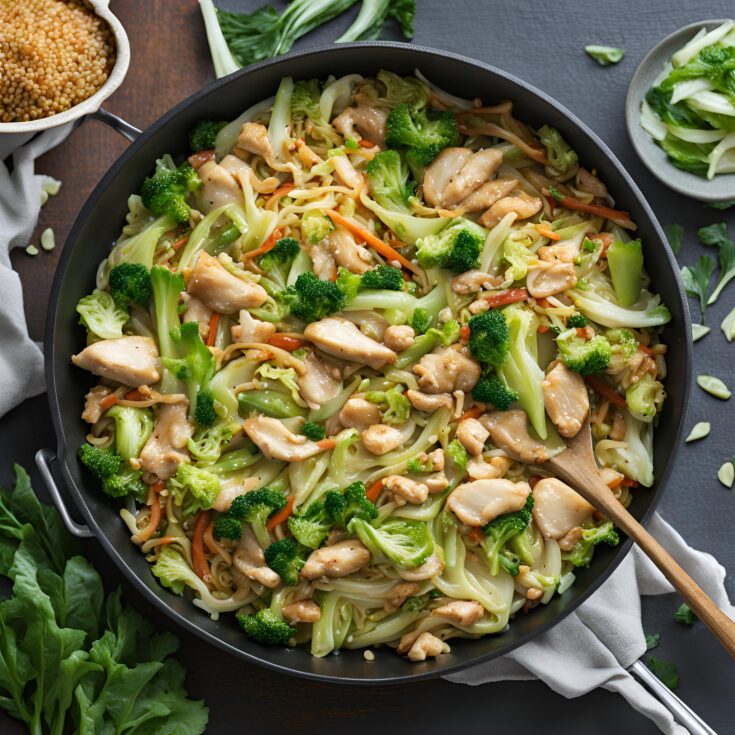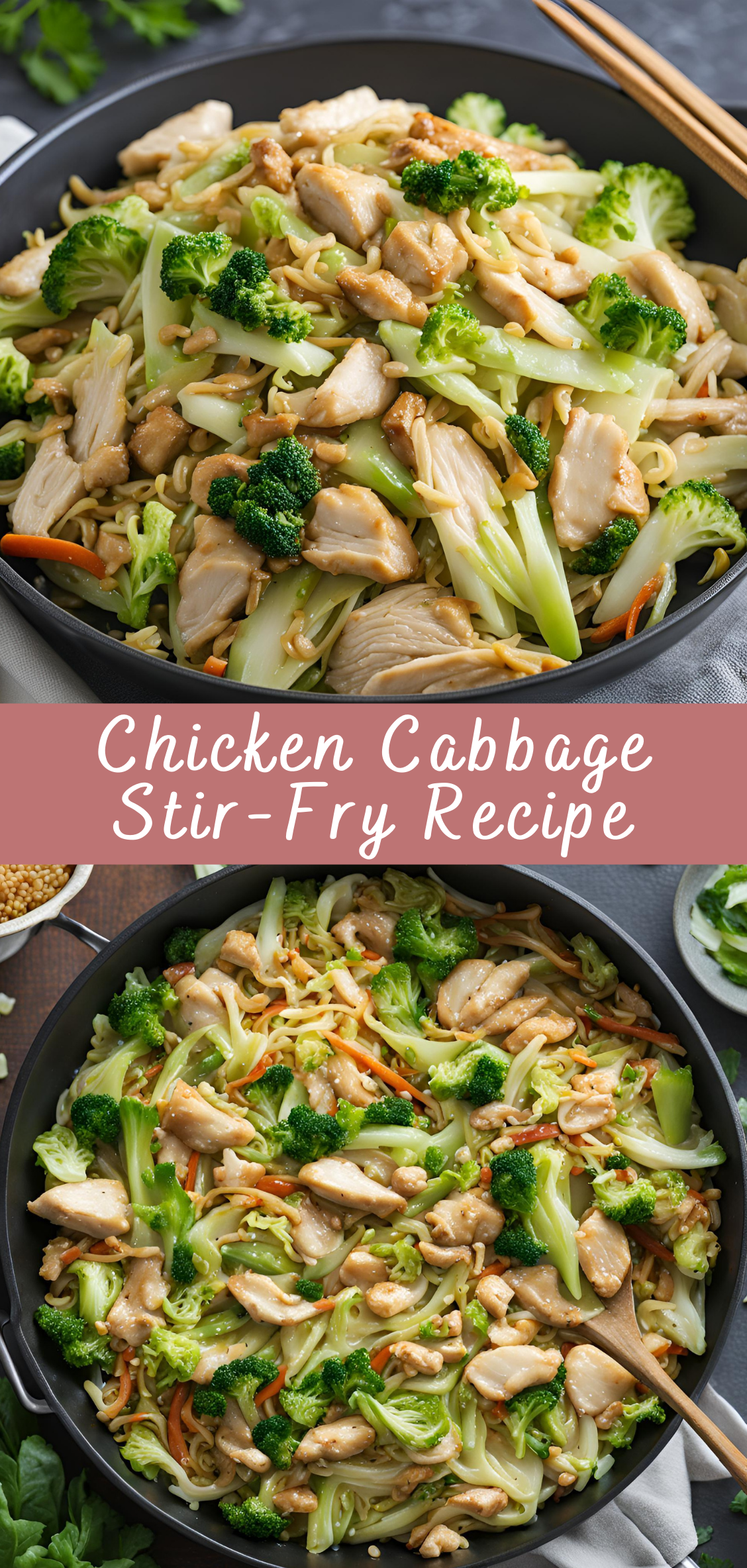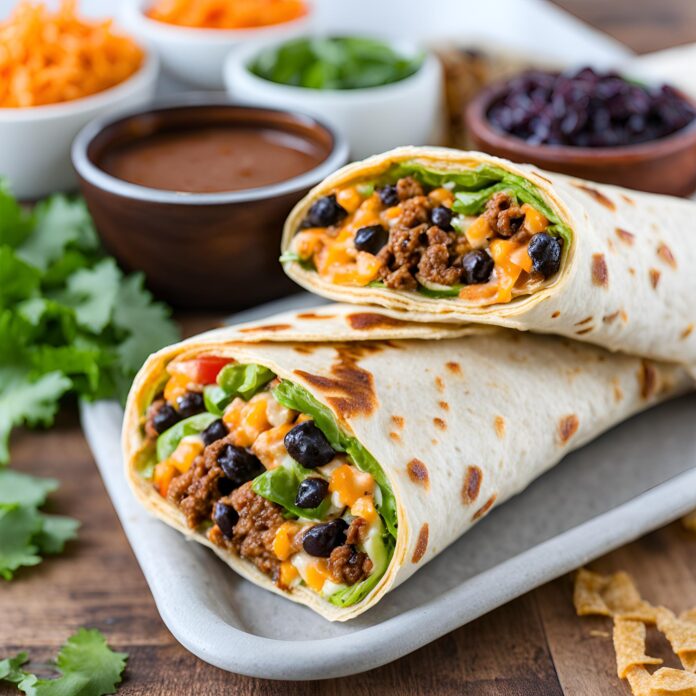Chicken Cabbage Stir-Fry Recipe
Chicken and cabbage stir-fry is a delicious and healthy dish that combines lean chicken breast or thighs with crunchy cabbage, savory vegetables, and a savory stir-fry sauce. This dish is quick, versatile, and can easily be adjusted to suit different taste preferences or dietary needs. The cabbage provides a nice contrast to the tender chicken and adds a subtle sweetness and crunch that makes each bite satisfying. The stir-fry sauce, typically made with soy sauce, garlic, ginger, and a touch of sesame oil, gives this dish a rich umami flavor with a slight sweetness.

Preparation Instructions
Now that we’ve gathered all the ingredients, let’s break down the preparation process for this tasty and satisfying dish.
1. Prepare the Ingredients:
Start by prepping everything before you begin stir-frying since stir-frying happens quickly.
- Chicken: Cut the chicken into thin strips or bite-sized cubes. The thinner the chicken, the faster it cooks, and the better it absorbs the flavors from the sauce. Season lightly with salt and pepper.
- Vegetables:
- Cabbage: Shred or chop the cabbage into bite-sized pieces. If you’re using green cabbage, remove the outer leaves if they’re too tough.
- Carrots: Peel and julienne the carrots (cut into matchstick-sized pieces). This helps the carrots cook quickly and evenly.
- Bell Pepper: Slice the bell pepper thinly, removing the seeds and stems.
- Onion: Slice the onion thinly into half-moons or rings.
- Garlic and Ginger: Mince the garlic and grate or finely chop the fresh ginger. These aromatics will add deep flavor to the stir-fry.
- Sauce Mixture: In a small bowl, whisk together the soy sauce, oyster sauce, rice vinegar, sesame oil, water or broth, and cornstarch mixture (if using) until well combined. This will form the base of the stir-fry sauce. If you like a more savory or salty profile, adjust the soy sauce. If you prefer a tangier flavor, increase the rice vinegar.
2. Cook the Chicken:
- Heat a large wok or frying pan over medium-high heat. Add 1 tablespoon of vegetable oil and allow it to heat up for a minute.
- Add the chicken to the hot pan, spreading it out in an even layer. Cook for 5-7 minutes until the chicken is cooked through and browned on all sides. Make sure not to crowd the chicken in the pan; you may need to do this step in batches if your pan is smaller.
- Once the chicken is cooked, remove it from the pan and set it aside. This prevents overcooking the chicken and allows the vegetables to be stir-fried next.
3. Stir-Fry the Vegetables:
- In the same wok or pan, add another tablespoon of vegetable oil and heat over medium-high heat.
- Add the onion and stir-fry for about 2 minutes, allowing it to soften slightly.
- Add the carrots and bell pepper and stir-fry for another 3-4 minutes until they begin to soften but still maintain some crunch.
- Add the cabbage, stirring continuously to prevent it from wilting too quickly. Stir-fry for about 2-3 minutes, just until the cabbage starts to soften but still has some texture and color. If the vegetables start to stick, you can add a splash of water or chicken broth to help them steam.
- Add the garlic and ginger to the pan, stir-frying for about 1 minute until fragrant.
4. Combine Chicken and Sauce:
- Once the vegetables are cooked to your liking, return the cooked chicken to the pan.
- Pour the sauce mixture over the chicken and vegetables. If you’re using cornstarch to thicken the sauce, you’ll notice the sauce begin to thicken as it heats up. Stir everything together until the sauce coats the chicken and vegetables evenly. Continue cooking for an additional 2 minutes until everything is heated through and well combined.
- Taste and adjust the seasoning by adding a little extra soy sauce, vinegar, or salt if needed.
5. Serve:
Once everything is well mixed and hot, remove the pan from the heat. Serve the stir-fry immediately, garnished with sesame seeds, chopped cilantro, or green onions. For extra crunch, sprinkle crushed peanuts or cashews on top. Serve over rice or noodles, or enjoy it on its own for a low-carb option.
Tips and Techniques
- Evenly Cut Ingredients: For the best stir-fry, cut all ingredients into similar sizes to ensure even cooking. Thin strips of chicken and vegetables cook faster and more uniformly, giving you the perfect stir-fry texture.
- High Heat is Key: Stir-frying is all about cooking quickly over high heat, which gives the vegetables a crisp texture and the chicken a nice sear. Make sure your pan or wok is very hot before adding the ingredients.
- Customize the Sauce: Feel free to adjust the sauce to match your preferences. If you prefer a sweeter flavor, add a small drizzle of honey or brown sugar. For more heat, add a teaspoon of chili paste, Sriracha, or red pepper flakes.
- Add More Veggies: You can easily add other vegetables like broccoli, snow peas, mushrooms, or baby corn to the stir-fry to increase the nutritional value and flavor complexity. Just be sure to adjust the cooking time so all the vegetables remain tender-crisp.
- Use Leftover Chicken: If you have leftover cooked chicken, this stir-fry recipe is an excellent way to repurpose it. Simply skip the step of cooking the chicken and add it directly with the sauce when you stir-fry the vegetables.
- Be Cautious with Soy Sauce: If you use regular soy sauce, the dish can be quite salty, so adjust accordingly. Opt for low-sodium soy sauce if you’re watching your sodium intake.
- Perfect Texture: If you like your cabbage extra crunchy, you can add it towards the end of cooking. If you prefer it more tender, let it cook a bit longer.
Variations and Customizations
This recipe is incredibly adaptable. Here are a few ways you can modify the dish:
1. Different Proteins:
- Beef: Use thinly sliced flank steak or sirloin for a beefy version of this stir-fry.
- Pork: Tender cuts like pork tenderloin or boneless pork chops work well.
- Shrimp: Shrimp cooks very quickly and adds a light, succulent option.
- Tofu: For a vegetarian or vegan version, use firm tofu, cubed and sautéed until golden. Press the tofu first to remove excess moisture.
2. Additional Vegetables:
- Mushrooms: Add sliced mushrooms for an earthy flavor.
- Snow Peas: Snow peas add a sweet crunch to the dish.
- Zucchini: Zucchini’s soft texture and subtle flavor pair well with cabbage.
3. Make it Spicy:
- Add a tablespoon of Sriracha or chili paste to the stir-fry sauce for a spicy kick. You can also top the dish with fresh sliced chilies.
4. Sweet and Sour Variation:
- For a sweet and sour twist, add a tablespoon of pineapple chunks or a splash of pineapple juice to the stir-fry sauce.
Serving Suggestions
This stir-fry can be served with a variety of accompaniments:
- Rice: Serve over steamed jasmine rice, brown rice, or cauliflower rice for a low-carb option.
- Noodles: Try pairing it with rice noodles, soba noodles, or even egg noodles for a more filling meal.
- Wraps: Serve in lettuce wraps or tortillas for a fresh, handheld option.
Exploring More Customization Options
While the basic recipe offers a fantastic starting point, there’s a world of possibilities for adjusting the flavors, textures, and even the cooking method to make the dish even more personal and suitable for various tastes. Let’s explore some additional options and tips to really make the Chicken Cabbage Stir-Fry shine!
1. Spice it Up with Heat
If you like your stir-fries with a little more kick, there are a few easy ways to add spice without overpowering the other flavors:
- Fresh Chilies: Add sliced fresh jalapeños, bird’s eye chilies, or Serrano peppers when stir-frying the vegetables. These fresh chilies will add a vibrant heat without becoming too overwhelming.
- Chili Oil or Chili Paste: Stir in a tablespoon of chili oil or chili paste like Sambal Oelek or Gochujang for a smoky, spicy flavor that complements the umami notes of the stir-fry. You can control the amount depending on how spicy you prefer your dish.
- Cayenne Pepper or Chili Flakes: For a quick and easy spice addition, sprinkle a little cayenne pepper or red chili flakes into the stir-fry sauce. Start with a pinch and adjust to your preferred heat level.
2. Enhance the Flavor with Additional Sauces
While the base stir-fry sauce is simple and savory, there are plenty of options to layer in even more flavor. Here are some ideas:
- Hoisin Sauce: This sweet, salty, and slightly spicy sauce adds depth and a touch of sweetness. Add a tablespoon of hoisin sauce to the stir-fry sauce mixture for extra flavor complexity.
- Fish Sauce: A few drops of fish sauce can elevate the umami of the dish. Just be careful, as fish sauce can be potent—start with a small amount and taste before adding more.
- Tamari: If you’re following a gluten-free diet, tamari (a gluten-free soy sauce alternative) can be used in place of regular soy sauce to maintain the dish’s rich flavor without any gluten.
- Maple Syrup or Honey: For a slightly sweeter variation, a small drizzle of maple syrup or honey balances the savory soy sauce and adds a touch of sweetness that complements the cabbage.
3. Boost Nutrients with Extra Veggies
While cabbage is the star of this dish, you can easily add more vegetables for variety and nutritional benefits. Here are some great options to incorporate into your stir-fry:
- Broccoli: Broccoli florets add a nutritious crunch to the stir-fry. Lightly blanch them before adding them to the pan to ensure they cook evenly and maintain a nice texture.
- Spinach or Kale: Adding leafy greens like spinach or kale can amp up the nutritional value. Add them toward the end of the stir-fry process to preserve their color and nutrients.
- Zucchini: Thinly sliced zucchini cooks quickly and pairs wonderfully with cabbage. It adds a subtle flavor and is great for soaking up the stir-fry sauce.
- Mushrooms: Whether using shiitake, cremini, or button mushrooms, mushrooms bring an earthy depth to the stir-fry. Slice them thinly and add them with the carrots and bell pepper for a hearty flavor.
- Green Beans or Snap Peas: For additional crunch and color, toss in some green beans or snap peas. They cook quickly and keep the dish light and fresh.
4. Make it More Filling
For a more substantial meal, you can add ingredients that will make the stir-fry heartier without compromising on flavor:
- Rice or Noodles: Serve your stir-fry over steamed white rice, brown rice, or jasmine rice for a comforting meal. You could also use fried rice for added texture and flavor. Alternatively, try adding rice noodles, udon noodles, or egg noodles to turn the stir-fry into a noodle-based dish.
- Quinoa or Cauliflower Rice: For a healthier, gluten-free option, serve the stir-fry over quinoa or cauliflower rice. These alternatives are rich in protein and fiber, providing extra nutrients without adding too many calories.
- Sweet Potatoes: If you’re looking for something hearty and nutritious, serve the stir-fry alongside roasted sweet potatoes. Their natural sweetness pairs perfectly with the savory flavors of the stir-fry.
- Eggs: Scramble in a couple of eggs at the end of cooking to turn the stir-fry into a chicken and cabbage fried rice dish. This adds richness and makes the dish more filling.
5. Incorporate a Sweet Twist
A touch of sweetness can balance the savory, spicy, and tangy elements in the stir-fry. Here are some ways to add a sweet note to the dish:
- Fruit: Pineapple, mango, or apple slices can bring a juicy, sweet contrast to the savory stir-fry. You can stir them in with the vegetables and let them cook slightly or toss them in at the very end to retain their freshness.
- Sweet Soy Sauce or Teriyaki Sauce: If you prefer a sweeter sauce base, you can substitute regular soy sauce with sweet soy sauce or teriyaki sauce. This will give the stir-fry a sweet-and-savory profile that works well with the cabbage.
6. Make It Vegan or Vegetarian
For a vegan or vegetarian version of the Chicken Cabbage Stir-Fry, simply substitute the chicken with plant-based proteins and ensure the sauces are free of animal products. Here are some ideas:
- Tofu: Use firm, extra-firm, or silken tofu. Press the tofu to remove excess moisture and cut it into cubes. Sauté the tofu until golden and crispy, then proceed with the recipe as directed.
- Tempeh: Tempeh has a firmer texture and a nutty flavor, making it an excellent choice for stir-fries. Slice the tempeh thinly and cook it until crispy.
- Seitan: If you’re not following a gluten-free diet, seitan is a great meat alternative that mimics the texture of chicken and soaks up flavors beautifully.
- Edamame: Edamame (young soybeans) can add a protein boost and are easy to toss into the stir-fry for extra texture.
7. Garnish and Present
Garnishing is the finishing touch that makes any dish look visually appealing and adds an extra burst of flavor. Here are some garnish ideas for your Chicken Cabbage Stir-Fry:
- Sesame Seeds: Toasted sesame seeds give a lovely crunch and add a subtle nutty flavor. Sprinkle them over the stir-fry just before serving.
- Fresh Herbs: Cilantro or green onions brighten the dish and provide a refreshing contrast to the rich flavors.
- Lime Wedges: A squeeze of fresh lime juice over the stir-fry before eating adds a zesty and tangy flavor that cuts through the richness of the sauce.
- Chili Peppers: For a burst of color and heat, garnish with thinly sliced red chili peppers or bird’s eye chilies.
- Crushed Peanuts or Cashews: Add extra texture and flavor with crushed peanuts or cashews. These nuts complement the savory and slightly sweet profile of the stir-fry.
Nutritional Benefits of Chicken Cabbage Stir-Fry
Let’s take a closer look at some of the key nutritional benefits of this dish:
- Chicken: Lean chicken is an excellent source of protein, which is essential for muscle repair and growth. It’s also a good source of B vitamins, particularly niacin (B3) and B6, which are important for energy metabolism and brain function.
- Cabbage: Cabbage is an incredibly nutritious vegetable, packed with vitamins C and K, both important for immune function and bone health. It’s also high in fiber, aiding digestion and promoting a healthy gut.
- Carrots and Bell Peppers: These colorful vegetables provide beta-carotene (which converts to vitamin A), important for eye health and immune function. They’re also rich in antioxidants, which help protect the body from oxidative stress.
- Ginger and Garlic: Both ginger and garlic have anti-inflammatory properties and contribute to overall immune system support. Garlic is also known for its heart health benefits, while ginger can aid digestion and reduce nausea.
- Healthy Fats from Sesame Oil: A small amount of sesame oil offers a good source of monounsaturated fats, which help support heart health and provide a rich flavor to the dish. Additionally, sesame oil contains sesamin, a lignan that has antioxidant properties.
Conclusion
The Chicken Cabbage Stir-Fry is an incredibly versatile dish that’s not only quick and easy to prepare but also packed with flavor, texture, and nutritional value. Whether you want to keep it simple with just chicken and cabbage or experiment with extra vegetables, sauces, and spices, this stir-fry is a blank canvas that allows you to customize it to suit your taste and dietary preferences.
By tweaking the sauce, adding extra veggies, switching up the protein, or garnishing with different toppings, you can make this dish your own and enjoy a meal that is both satisfying and wholesome. Best of all, it’s a one-pan wonder that’s perfect for weeknight dinners, meal prep, or serving to guests.
Chicken Cabbage Stir-Fry is a healthy, vibrant, and quick meal that’s packed with flavor. It combines lean protein with fresh vegetables in a savory sauce that’s easy to prepare. The dish is highly customizable, making it perfect for different tastes and dietary preferences. Whether you’re making a weeknight dinner or preparing for a meal prep session, this stir-fry is a versatile and satisfying choice.
Enjoy making this simple yet delicious dish and explore the endless possibilities for variations and additions to make it your own!
Chicken Cabbage Stir-Fry Recipe

Chicken and cabbage stir-fry is a delicious and healthy dish that combines lean chicken breast or thighs with crunchy cabbage, savory vegetables, and a savory stir-fry sauce. This dish is quick, versatile, and can easily be adjusted to suit different taste preferences or dietary needs. The cabbage provides a nice contrast to the tender chicken and adds a subtle sweetness and crunch that makes each bite satisfying. The stir-fry sauce, typically made with soy sauce, garlic, ginger, and a touch of sesame oil, gives this dish a rich umami flavor with a slight sweetness.
Ingredients
- 1 lb boneless, skinless chicken breast (or thighs), thinly sliced
- 4 cups cabbage, shredded (green or a mix of green and purple)
- 1 medium onion, thinly sliced
- 1 bell pepper, sliced (optional)
- 2 cloves garlic, minced
- 1-inch piece of ginger, grated (optional, for extra flavor)
- 2 tbsp soy sauce (or tamari for gluten-free)
- 1 tbsp rice vinegar
- 1 tbsp hoisin sauce (optional, for sweetness)
- 1 tbsp sesame oil (or olive oil)
- 1 tbsp vegetable oil (for stir-frying)
- 1 tsp chili flakes (optional, for heat)
- 1 tsp sesame seeds (optional, for garnish)
- Fresh cilantro or green onions for garnish (optional)
- Salt and pepper to taste
Instructions
1. Prepare the Ingredients:
- Thinly slice the chicken breast (or thighs) into strips. Season with a pinch of salt and pepper.
- Shred the cabbage and slice the onion and bell pepper (if using). Mince the garlic and grate the ginger.
- In a small bowl, mix together the soy sauce, rice vinegar, hoisin sauce (if using), and chili flakes (if using). Set aside.
2. Cook the Chicken:
- Heat a wok or large skillet over medium-high heat. Add 1 tablespoon of vegetable oil.
- Once hot, add the chicken strips in a single layer. Let them cook for 3-4 minutes, undisturbed, until golden brown. Flip and cook the other side for another 2-3 minutes until the chicken is cooked through. Remove the chicken from the pan and set it aside.
3. Stir-Fry the Vegetables:
- In the same pan, add the sesame oil (or olive oil) and heat over medium-high heat.
- Add the sliced onion, bell pepper (if using), and shredded cabbage. Stir-fry for 5-7 minutes, or until the cabbage softens and begins to caramelize. Add the minced garlic and grated ginger, and cook for another minute until fragrant.
4. Combine the Chicken and Sauce:
- Return the cooked chicken to the pan with the vegetables. Pour the sauce mixture over the chicken and veggies, tossing to coat everything evenly. Stir-fry for another 2-3 minutes to combine and heat through.
5. Serve:
- Serve the stir-fry in bowls and garnish with sesame seeds and fresh cilantro or green onions, if desired.
Notes
- Customizable Recipe:
This stir-fry is extremely adaptable. You can switch the chicken for other proteins like tofu, shrimp, beef, or even tempeh for a vegan version.
Feel free to add more vegetables like broccoli, zucchini, mushrooms, or snap peas to suit your preferences or add extra nutrition. - Sauce Adjustments:
The sauce in this recipe is meant to be savory with a hint of sweetness and acidity, but you can adjust the balance based on your taste. If you like it spicier, add chili flakes or Sriracha. If you prefer it sweeter, you can add a touch of honey or maple syrup. - Thickening the Sauce:
If you want a thicker sauce, consider adding a cornstarch slurry (mixing cornstarch with water) towards the end of cooking. This will give the sauce a glossy, velvety texture. - Healthy Modifications:
For a lower-carb option, serve the stir-fry over cauliflower rice or enjoy it on its own as a light, nutrient-dense meal.
You can make it gluten-free by ensuring the soy sauce used is gluten-free (like tamari) and skipping any ingredients that might contain gluten. - Meal Prep:
This dish is great for meal prepping. You can store the cooked stir-fry in an airtight container in the fridge for up to 3 days. If you're making a larger batch, you can also freeze the stir-fry (without rice) for up to 2 months. - Cooking Tips:
Stir-frying works best on high heat, so ensure your pan or wok is preheated before adding the ingredients.
Don’t overcrowd the pan when cooking the chicken, as this can cause it to steam rather than sear. You may need to cook the chicken in batches if your pan is too small.
For even cooking, chop the vegetables and chicken into similar-sized pieces. - Garnish and Serving:
Garnish with toasted sesame seeds, sliced green onions, or fresh cilantro for a burst of flavor and color.
Serve with a side of steamed rice, quinoa, or noodles for a heartier meal.



